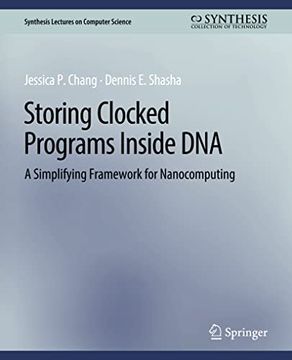Compartir
Storing Clocked Programs Inside DNA: A Simplifying Framework for Nanocomputing (en Inglés)
Dennis Shasha
(Autor)
·
Jessica Chang
(Autor)
·
Springer
· Tapa Blanda
Storing Clocked Programs Inside DNA: A Simplifying Framework for Nanocomputing (en Inglés) - Chang, Jessica ; Shasha, Dennis
$ 26.52
$ 27.99
Ahorras: $ 1.47
Elige la lista en la que quieres agregar tu producto o crea una nueva lista
✓ Producto agregado correctamente a la lista de deseos.
Ir a Mis ListasSe enviará desde nuestra bodega entre el
Jueves 30 de Mayo y el
Viernes 31 de Mayo.
Lo recibirás en cualquier lugar de Estados Unidos entre 1 y 3 días hábiles luego del envío.
Reseña del libro "Storing Clocked Programs Inside DNA: A Simplifying Framework for Nanocomputing (en Inglés)"
In the history of modern computation, large mechanical calculators preceded computers. A person would sit there punching keys according to a procedure and a number would eventually appear. Once calculators became fast enough, it became obvious that the critical path was the punching rather than the calculation itself. That is what made the stored program concept vital to further progress. Once the instructions were stored in the machine, the entire computation could run at the speed of the machine. This book shows how to do the same thing for DNA computing. Rather than asking a robot or a person to pour in specific strands at different times in order to cause a DNA computation to occur (by analogy to a person punching numbers and operations into a mechanical calculator), the DNA instructions are stored within the solution and guide the entire computation. We show how to store straight line programs, conditionals, loops, and a rudimentary form of subroutines. To achieve this goal, the book proposes a complete language for describing the intrinsic topology of DNA complexes and nanomachines, along with the dynamics of such a system. We then describe dynamic behavior using a set of basic transitions, which operate on a small neighborhood within a complex in a well-defined way. These transitions can be formalized as purely syntactical functions of the string representations. Building on that foundation, the book proposes a novel machine motif which constitutes an instruction stack, allowing for the clocked release of an arbitrary sequence of DNA instruction or data strands. The clock mechanism is built of special strands of DNA called ""tick"" and ""tock."" Each time a ""tick"" and ""tock"" enter a DNA solution, a strand is released from an instruction stack (by analogy to the way in which as a clock cycle in an electronic computer causes a new instruction to enter a processing unit). As long as there remain strands on the stack, the next cycle will release a new instruction strand. Regardless of the actual strand or component to be released at any particular clock step, the ""tick"" and ""tock"" fuel strands remain the same, thus shifting the burden of work away from the end user of a machine and easing operation. Pre-loaded stacks enable the concept of a stored program to be realized as a physical DNA mechanism. A conceptual example is given of such a stack operating a walker device. The stack allows for a user to operate such a clocked walker by means of simple repetition of adding two fuel types, in contrast to the previous mechanism of adding a unique fuel -- at least 12 different types of strands -- for each step of the mechanism. We demonstrate by a series of experiments conducted in Ned Seeman's lab that it is possible to ""initialize"" a clocked stored program DNA machine. We end the book with a discussion of the design features of a programming language for clocked DNA programming. There is a lot left to do. Table of Contents: Introduction / Notation / A Topological Description of DNA Computing / Machines and Motifs / Experiment: Storing Clocked Programs in DNA / A Clocked DNA Programming Language
- 0% (0)
- 0% (0)
- 0% (0)
- 0% (0)
- 0% (0)
Todos los libros de nuestro catálogo son Originales.
El libro está escrito en Inglés.
La encuadernación de esta edición es Tapa Blanda.
✓ Producto agregado correctamente al carro, Ir a Pagar.

